
A PLETHORA OF PEPPERS
07/14/17 — Heydon Hatcher
Peppers, peppers, peppers. With an endless string of nearly 100 degree days under our belt, marinating in our own sweat has become commonplace. While we are struggling to keep from going heat-crazy, our pepper crops are basking in the sunshine, and thriving in the brutal heat. Plentiful peppers abound on the farm currently! Peppers here, peppers there - we got ‘em everywhere! We pride ourselves on constantly innovating here at JBG, and just like the melons, we have had a good ole time testing the waters on a wide range of new varieties of this sweet and spicy crop. Here’s to the Capsicum genus, ranging from flaming hot to sweet as sugar, you make the dog days of summer worthwhile!
![Photo by Scott David Gordon.]() Photo by Scott David Gordon.
Photo by Scott David Gordon.
![Peppers! Photo by Scott David Gordon.]() Peppers! Photo by Scott David Gordon.
Peppers! Photo by Scott David Gordon.
![Photo by Scott David Gordon.]() Photo by Scott David Gordon.
Photo by Scott David Gordon.
Bell Pepper - Looking at the bell pepper harvest is always mesmerizing. These peppers have the most stunning spectrum of colors (this year we have green, red, white, orange, chocolate, yellow, purple bells!), and are the darling of the sweet pepper category. The taste changes with the color… red being the ripest and sweetest. A JBG favorite recipe is the culturally ubiquitous stuffed bell pepper.
![Photo by Scott David Gordon.]() Bell pepper gradient. Photo by Scott David Gordon.
Bell pepper gradient. Photo by Scott David Gordon.
Banana - A mild pepper known for its banana-like aesthetics. This pepper is perfect for pickling, a yummy addition to sandwiches.
![Shishitos. Photo by Scott David Gordon.]() Shishitos. Photo by Scott David Gordon.
Shishitos. Photo by Scott David Gordon.
Padron - Hailing from Padron, Spain, these small peppers are perfect for frying as well. In Spain they usually blister with oil and salt to serve as a tapas dish. Ranging from a deep green to yellowish green (sometimes red!), these Spanish are mild as bell peppers with one in ten packing a very spicy punch, just like the shishitos.
![Jalapeno business. Photo by Scott David Gordon.]() Jalapeno business. Photo by Scott David Gordon.
Jalapeno business. Photo by Scott David Gordon.
Serrano - Originating from the mountains in Mexico, these green, (turning red as they ripen like the jalapeño) spindly little peppers can pack a punch! Hotter when they are smaller, serranos are used frequently in a lot of salsas and sauces.
![Photo by Scott David Gordon.]() Hot pepper medley - Habaneros are the bright orange, and serranos are the green/red pepper baskets. Photo by Scott David Gordon.
Hot pepper medley - Habaneros are the bright orange, and serranos are the green/red pepper baskets. Photo by Scott David Gordon.
Habanero - This vibrant orange and wrinkly pepper, although small, packs SO. MUCH. HEAT. It is known as one of the spiciest peppers, and as such, makes for the perfect hot sauce ingredient. Dr. Stadnyk’s uses our habaneros to make their delectable hot sauce infused with carrots to subdue the amount of heat. This is our head farmer’s favorite to cook with - it adds such a distinct taste to any recipe, and that spice sure does have an intoxicating effect.
Cherry Bomb - When our head farmer, Brenton, went to Italy, he saw these everywhere! These hot peppers are tiny (about 2 inches in length), bright red, and look just like a cherry tomato. They are moderately spicy and perfect for stuffing or pickling!
![Photo by Scott David Gordon.]() Cherry Bomb peppers. Photo by Scott David Gordon.
Cherry Bomb peppers. Photo by Scott David Gordon.
![Photo by Scott David Gordon.]() Sheepnose Pimento. Photo by Scott David Gordon.
Sheepnose Pimento. Photo by Scott David Gordon.
Hinkelhatz - Another Ark of Taste variety, deemed Hinkelhatz because of it’s resemblance to a chicken heart (Hinkelhatz means “chicken heart” in German). Preserved by the Pennsylvania Dutch Mennonite community since the late 1800s and thought to originate in Mexico, this spicy pepper is great for vinegar and pickling.
Wenk’s Yellow Hots - Waxy with a thick skin, these moderately hot yellow peppers are great for pickles!
Beaver Dam - Mildly hot, crunchy, and slightly sweet, these peppers were brought to Beaver Dam, Wisconsin by Hungarian immigrants in the early 1900s. They are long and wedge-shaped, great for pickling, stuffing, salsas or goulash.
Pequin - Hailing from Mexico, this variety is a very small pepper that is usually used as a spice. This little guy really brings the heat, throw a pinch of this into whatever dish you really want add a little sizzle to, or sprinkle it on fruit!
![Photo by Scott David Gordon.]() Pequins. Photo by Scott David Gordon.
Pequins. Photo by Scott David Gordon.
Tabasco - Sound familiar? That’s right, this is the pepper they use to make the ubiquitous Tabasco hot sauce. It has a delicious smoky flavor, turns red when it matures, and originates from Mexico.
Jimmy Nardello - Anaheim - Living in Southern Italy, Jimmy Nardello’s mother, Angella, loved peppers to no bounds. When the Nardello’s decided to pursue a life in America in the late 1800s, Angella brought a handful of her most favorite sweet frying pepper seeds to America with her. Jimmy (their fourth child and the pepper’s namesake) inherited his mother’s love of this veggie, and cultivated this beloved frying pepper in his garden until he died. Before he passed, he shared some of his heirloom seeds with the Seeds Savers Exchange, and since they have been spreading this seed the world around! With a thin skin and a deep red hue, these peppers are perfect for frying and also for drying!
![Photo by Scott David Gordon.]() Jimmy Nardellos. Photo by Scott David Gordon.
Jimmy Nardellos. Photo by Scott David Gordon.
In the mood for some peppers yet? Visit us at markets this weekend and grab a handful! 'Til next time!
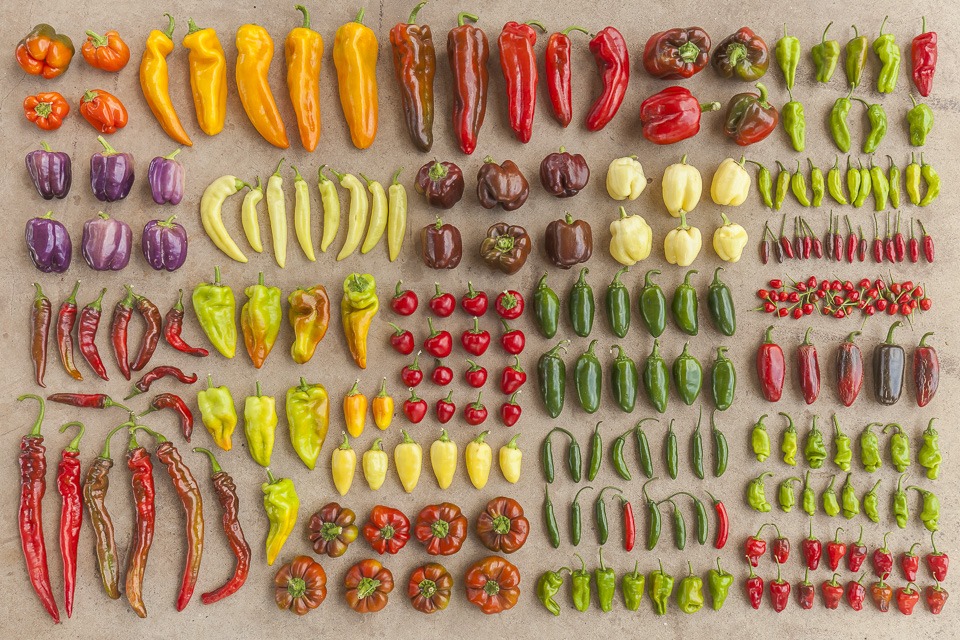 Photo by Scott David Gordon.
Photo by Scott David Gordon.
A Brief History
Originating in South America thousands of years ago, these members of the nightshade family’s cultivation spread to Central America soon after, and ultimately, through the Columbian Exchange (wherein Christopher Columbus kindled a massive exchange of goods between the Eastern and Western hemispheres during the 15th and 16th centuries) to Europe. Currently, peppers are utilized worldwide, enriching a plethora of different culinary traditions, from Spanish chorizo and Indian capsicum curry to the Congolese pili-pili sauce.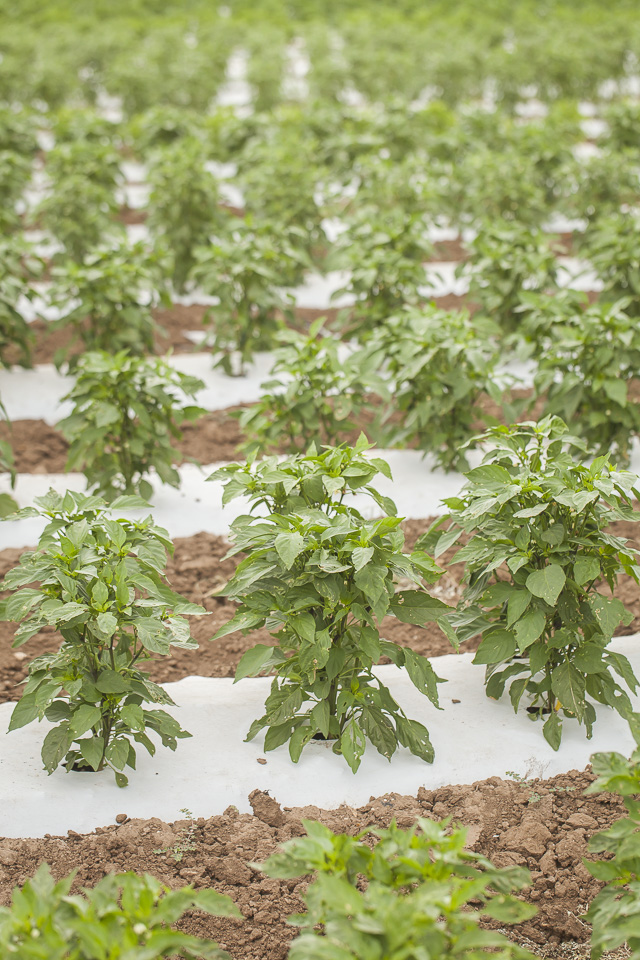 Peppers! Photo by Scott David Gordon.
Peppers! Photo by Scott David Gordon.
Nutritional Fun Facts
- All peppers have differing levels of capsaicin, a chemical compound that dissolves in fats and oils, in them. Bell peppers have little to none, and habaneros have some of the highest levels. This chemical causes a burning sensation on whatever tissue with which it comes into contact. This keeps mammals from eating the hotter peppers, because of the undesirable and sometimes painful side effects; whereas birds, whose receptors are largely unaffected by it, indulge in peppers and spread the seeds.
- No wonder it burns! Capsaicin is known to aid in burning fat and boost metabolism!
- A red, yellow, or green bell pepper has more Vitamin C than an orange, and are good sources of carotenoids, which act as antioxidants in the body as well as support ocular and epidermal health. The more they ripen, the more nutrition you get!
- Hot or sweet, peppers have a ton of B vitamins as well, namely B6, which higher consumption of is known to quell heart disease and stroke.
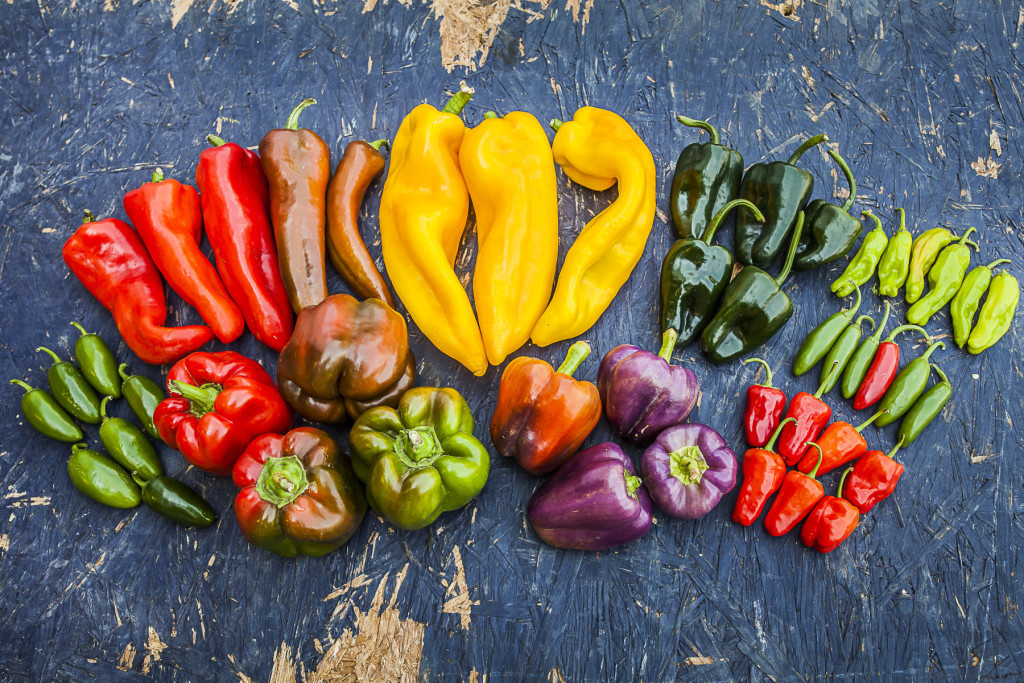 Photo by Scott David Gordon.
Photo by Scott David Gordon.
Sweet Peppers
Yellow/Red Italian - These Italian varieties are the sweetest peppers on the farm… ‘sweet as sugar’ as our farm manager, Becky, says. When the harvest reaches the barn, folks cannot resist grabbing a handful and taking a big juicy bite. These are perfect for snacking (kids love them!) or delicious roasted, whether as a side dish or on an antipasto plate!Bell Pepper - Looking at the bell pepper harvest is always mesmerizing. These peppers have the most stunning spectrum of colors (this year we have green, red, white, orange, chocolate, yellow, purple bells!), and are the darling of the sweet pepper category. The taste changes with the color… red being the ripest and sweetest. A JBG favorite recipe is the culturally ubiquitous stuffed bell pepper.
 Bell pepper gradient. Photo by Scott David Gordon.
Bell pepper gradient. Photo by Scott David Gordon.
Banana - A mild pepper known for its banana-like aesthetics. This pepper is perfect for pickling, a yummy addition to sandwiches.
Frying Peppers
Shishito - A Central Texas favorite, this mild little pepper hailing from East Asia is great for tempura, or a quick saute. Take a peek at one of our resident recipe blogger’s escapade into a blissful blistering of these green beauties. Brenton, our head farmer, loves hand-frying these peppers with some oil, garlic, and kosher salt! Watch out though, most of these peppers are on the milder side, but once in a blue moon you’ll get a kick of spicy shishito! BAM!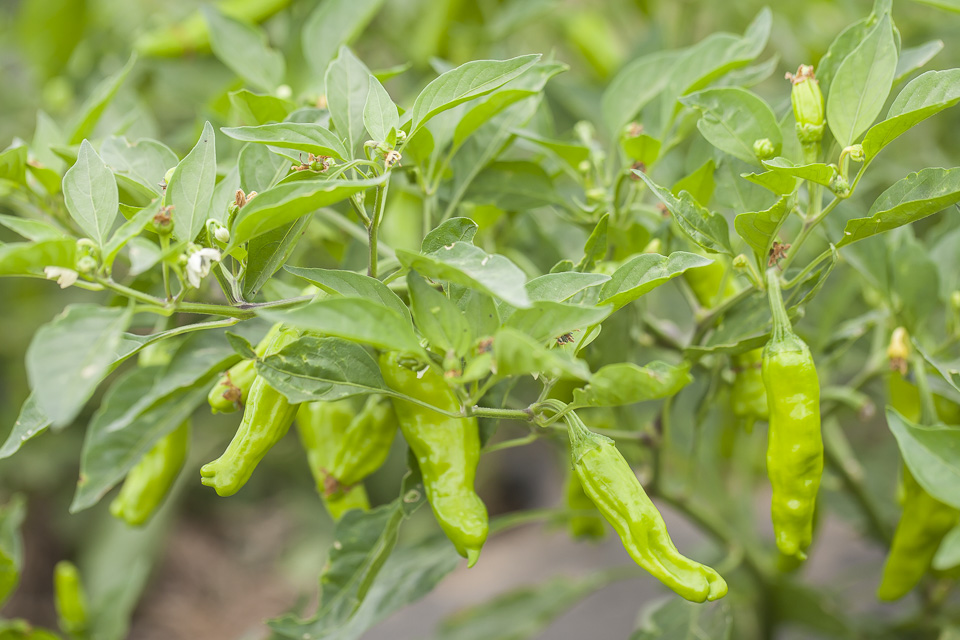 Shishitos. Photo by Scott David Gordon.
Shishitos. Photo by Scott David Gordon.
Padron - Hailing from Padron, Spain, these small peppers are perfect for frying as well. In Spain they usually blister with oil and salt to serve as a tapas dish. Ranging from a deep green to yellowish green (sometimes red!), these Spanish are mild as bell peppers with one in ten packing a very spicy punch, just like the shishitos.
Hot Peppers
Jalapeño - Smooth and green (turning red as they ripen), these peppers are milder and wider than serranos. These are sublime stuffed with cheese and wrapped with bacon or as a sauce... we’re thinking specifically of Tacodeli’s dreamy Doña sauce!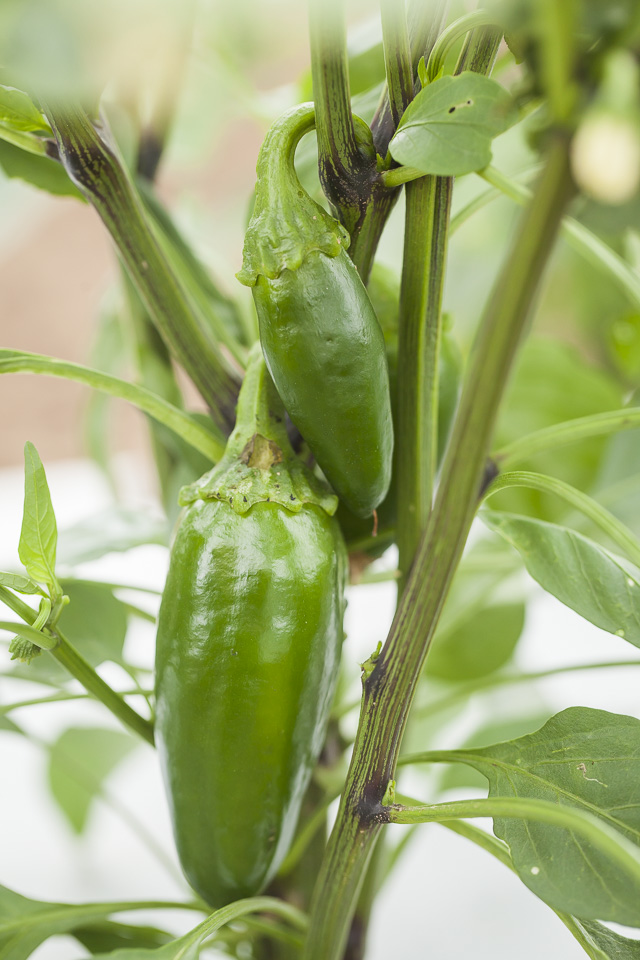 Jalapeno business. Photo by Scott David Gordon.
Jalapeno business. Photo by Scott David Gordon.
Serrano - Originating from the mountains in Mexico, these green, (turning red as they ripen like the jalapeño) spindly little peppers can pack a punch! Hotter when they are smaller, serranos are used frequently in a lot of salsas and sauces.
 Hot pepper medley - Habaneros are the bright orange, and serranos are the green/red pepper baskets. Photo by Scott David Gordon.
Hot pepper medley - Habaneros are the bright orange, and serranos are the green/red pepper baskets. Photo by Scott David Gordon.
Habanero - This vibrant orange and wrinkly pepper, although small, packs SO. MUCH. HEAT. It is known as one of the spiciest peppers, and as such, makes for the perfect hot sauce ingredient. Dr. Stadnyk’s uses our habaneros to make their delectable hot sauce infused with carrots to subdue the amount of heat. This is our head farmer’s favorite to cook with - it adds such a distinct taste to any recipe, and that spice sure does have an intoxicating effect.
Cherry Bomb - When our head farmer, Brenton, went to Italy, he saw these everywhere! These hot peppers are tiny (about 2 inches in length), bright red, and look just like a cherry tomato. They are moderately spicy and perfect for stuffing or pickling!
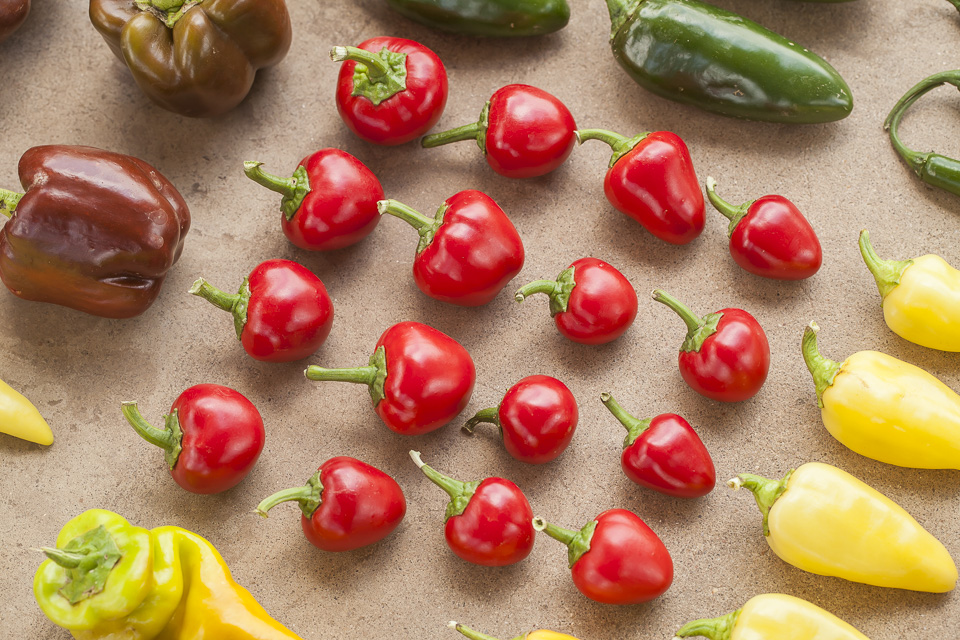 Cherry Bomb peppers. Photo by Scott David Gordon.
Cherry Bomb peppers. Photo by Scott David Gordon.
Heirloom Peppers
Sheepnose Pimento - This sweet pepper is an Ark of Taste variety and is quite a delectable, juicy snacking pepper. It has a thick flesh and is prime for canning, or throw 'em in the oven to bake!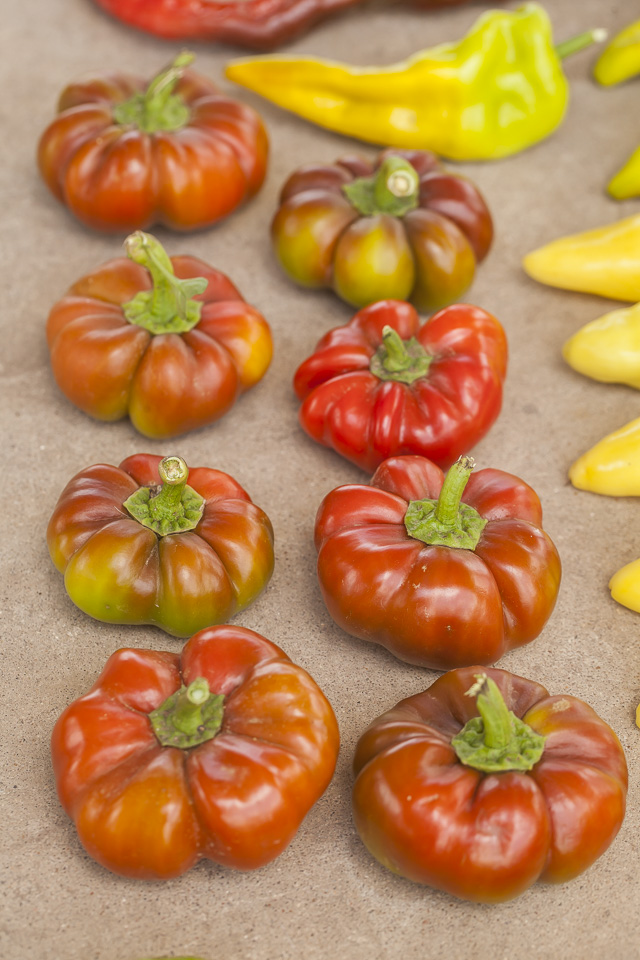 Sheepnose Pimento. Photo by Scott David Gordon.
Sheepnose Pimento. Photo by Scott David Gordon.
Hinkelhatz - Another Ark of Taste variety, deemed Hinkelhatz because of it’s resemblance to a chicken heart (Hinkelhatz means “chicken heart” in German). Preserved by the Pennsylvania Dutch Mennonite community since the late 1800s and thought to originate in Mexico, this spicy pepper is great for vinegar and pickling.
Wenk’s Yellow Hots - Waxy with a thick skin, these moderately hot yellow peppers are great for pickles!
Beaver Dam - Mildly hot, crunchy, and slightly sweet, these peppers were brought to Beaver Dam, Wisconsin by Hungarian immigrants in the early 1900s. They are long and wedge-shaped, great for pickling, stuffing, salsas or goulash.
Pequin - Hailing from Mexico, this variety is a very small pepper that is usually used as a spice. This little guy really brings the heat, throw a pinch of this into whatever dish you really want add a little sizzle to, or sprinkle it on fruit!
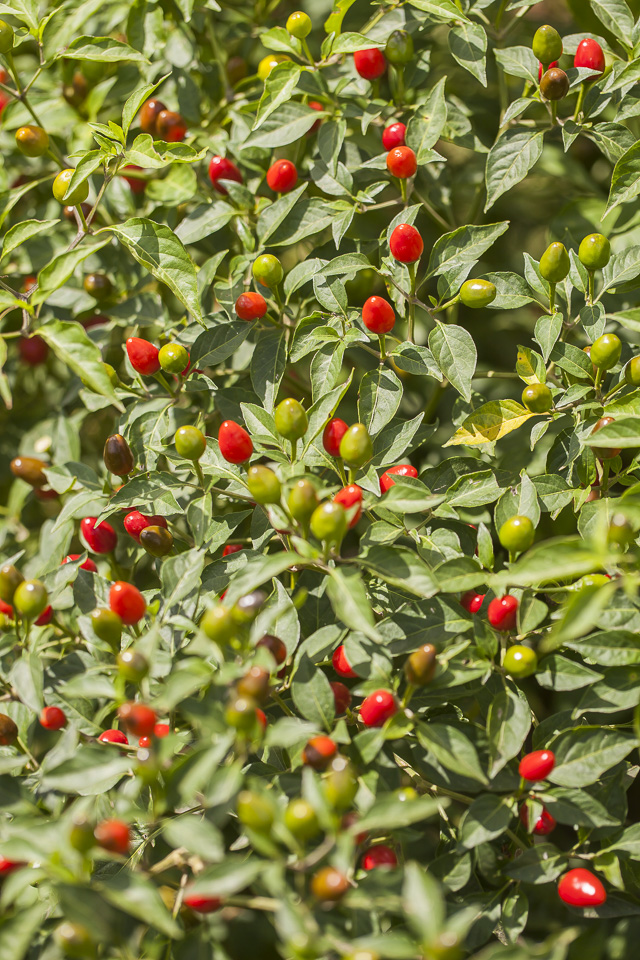 Pequins. Photo by Scott David Gordon.
Pequins. Photo by Scott David Gordon.
Tabasco - Sound familiar? That’s right, this is the pepper they use to make the ubiquitous Tabasco hot sauce. It has a delicious smoky flavor, turns red when it matures, and originates from Mexico.
Jimmy Nardello - Anaheim - Living in Southern Italy, Jimmy Nardello’s mother, Angella, loved peppers to no bounds. When the Nardello’s decided to pursue a life in America in the late 1800s, Angella brought a handful of her most favorite sweet frying pepper seeds to America with her. Jimmy (their fourth child and the pepper’s namesake) inherited his mother’s love of this veggie, and cultivated this beloved frying pepper in his garden until he died. Before he passed, he shared some of his heirloom seeds with the Seeds Savers Exchange, and since they have been spreading this seed the world around! With a thin skin and a deep red hue, these peppers are perfect for frying and also for drying!
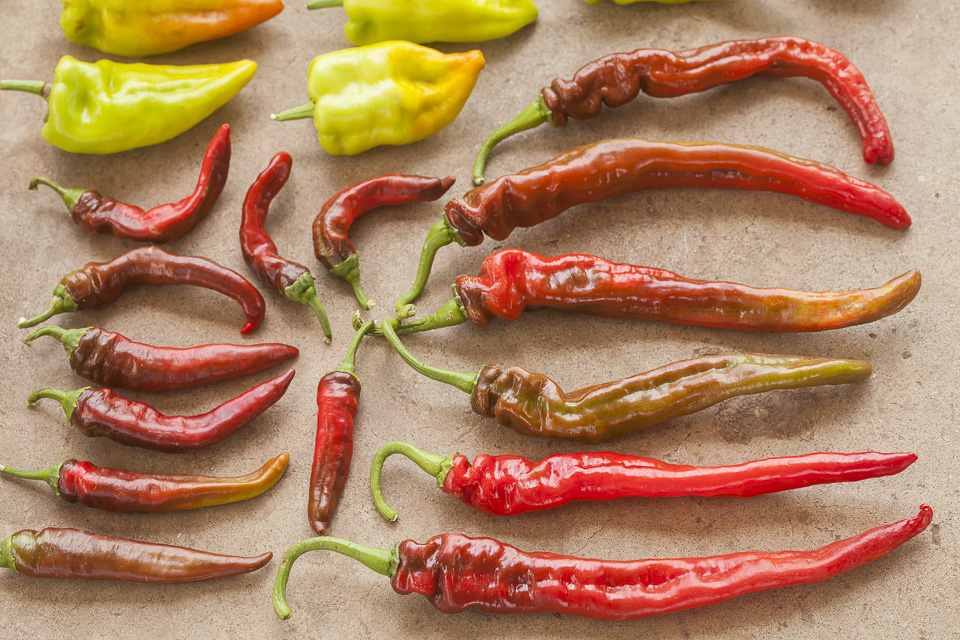 Jimmy Nardellos. Photo by Scott David Gordon.
Jimmy Nardellos. Photo by Scott David Gordon.
In the mood for some peppers yet? Visit us at markets this weekend and grab a handful! 'Til next time!






 0 ITEMS IN CART
0 ITEMS IN CART 

